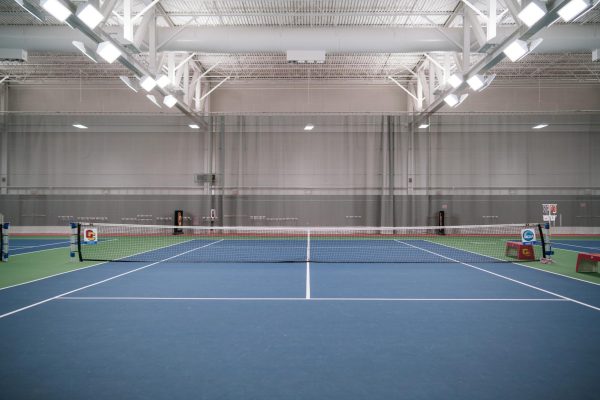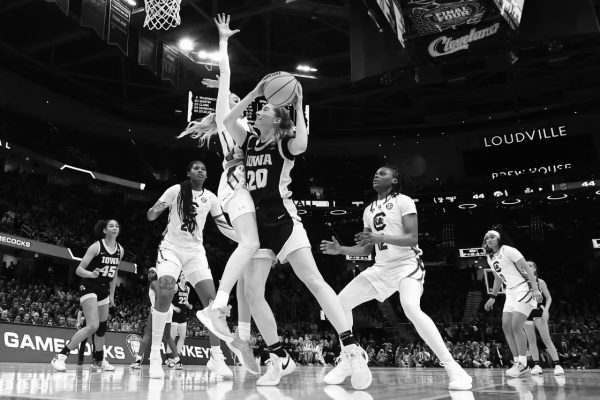LeBron’s ‘Student Athlete’ Exposes NCAA Hypocrisy
Shamar Graves sat in the home bleachers of the Woodbridge High School football stadium with a wistful expression on his face, overlooking the field he sprinted up and down over a decade ago as a star wide receiver.
The sky was the limit back then. Graves was offered more athletic scholarships than he could keep track of, and making it to the NFL seemed like a feasible dream.
After playing four seasons as tight end for the Scarlet Knights, Graves got his degree from Rutgers University. But his post-graduation options were limited. A shoulder injury derailed his chances of trying out for an NFL team, and he didn’t have a plan B.
Graves woke every morning at 4 a.m. for his shift at Old Navy. Then he taught at a middle school. Then he coached a youth football team. Then he worked a two-hour shift at Dick’s Sporting Goods. Then he worked as a security guard.
He worked 18-hour days, yet only made $1,500 a month.
In the opening scene of Student Athlete — an 88-minute documentary which aired Tuesday on HBO — Graves pulls into an empty parking garage and turns his car engine off. He pulls a blanket over himself and goes to sleep. He’s homeless.
Student Athlete — which was co-produced by Los Angeles Lakers star LeBron James and his business manager, Maverick Carter — sheds light on the hypocrisy of the National Collegiate Athletic Association. While schools are bringing in millions of dollars in revenue, the players who make it all possible see none of it. The film follows the stories of five men who have been failed by the NCAA model.
In addition to Graves, we meet Nick Richards, a Jamaican immigrant and 18-year-old enduring the demands of being one of the top high school basketball prospects in the country; Mike Shaw, whose debilitating back pain forced him to quit basketball and prompted mental health issues; Silas Nacita, a former walk-on football player for Baylor University who was dismissed from the program after receiving housing and financial help from a family friend; and John Shoop, a former college football coach who was blacklisted for advocating for student-athletes’ rights.
The film makes clear that, while select student-athletes receive a free education, they are not at school to achieve academic success. They’re tools used to rake in money and win games. They don’t get to pursue interests outside of their sport, and they don’t have the time to network and explore internships that will set them up for success after college. They can’t attend study sessions or meet with their professors for extra help because they have practices, lifts, film sessions, and meetings every day. Sometimes I wonder if Division I athletes at major schools have time to eat.
“I’ve always heard the narrative that [college athletes] get a free education, but you guys are not bringing me on campus to get an education,” James said. “You guys are bringing me on it to help you get to a Final Four or to a national championship, so it’s just a weird thing. I’m not a fan of the NCAA. The NCAA is corrupt.”
The NCAA argues that schools provide student-athletes with the resources to make it big. College recruiters ensure prospects that their program will help get them to the promised land. But what happens when an athlete just isn’t good enough, or when their chances of becoming a professional athlete are shot down by an injury?
As of April 2018, only 1.2 percent of men’s college basketball players make it to the NBA, and only 1.6 percent of college football players make it to the NFL. The odds are stacked against college athletes, many of whom strive to make it to the next level in order to provide for their families.
Many of these athletes struggle to pay for college as well. While the NCAA surpassed $1 billion in revenue for the first time in 2017, and many major college sports programs bring in millions of dollars, the money goes into coaches’ salaries and state-of-the-art athletic facilities, not back to the student-athletes who win games and championship titles.
“The thing that’s disgusting in college is that coaches are making millions of dollars, and they’re coaching players whose families live below the poverty line,” Shoop said.
Shoop claimed he asked 50 different players of his if they would rather have a locker room worth $10,000 with a 40-inch flat-screen TV, or portions of that money sent back to their families. Every single player chose the latter.
“I know people say, ‘Well, these players get everything,’” Shoop said. “No, they don’t get everything. What they get is a facility that might have a barber shop in it, tons of flat-screen TVs, [and] they might get a bunch of Nike spikes. At this time in their life when they really did have incredible value, I was the one absorbing all that value. Not them. That didn’t feel good to me. I was the one getting paid, and paid a lot. Not them.”
The three highest-paid college football coaches are currently University of Alabama Head Coach Nick Saban ($8.3 million), Ohio State University Head Coach Urban Meyer ($7.6 million), and University of Michigan Head Coach Jim Harbaugh ($7.5 million). It’s absurd that coaches are making millions while there are players out there who don’t have a roof over their head or enough money to put food on the table.
If the NCAA isn’t going to pay its student-athletes, then it should at least take a good, hard look at its rules. If a student-athlete is struggling to get by, they should be allowed to accept help from family friends and others wanting to help out. Either the NCAA is in denial, or it simply doesn’t care about student-athletes’ well-being.
While James’ documentary isn’t going to fix any structural issues within the NCAA, it should at least turn some heads — especially those who can relate to the struggles faced by the five men highlighted in the film.
“What the players don’t recognize is that they are the game,” said Don Lee, agent of New England Patriots legend Tom Brady. “And when you are the game, you are everything. No one else has the talent to do what they can do. That gives you immense leverage to create something better for yourselves if you have the vision and courage to do it. The players, I’m telling you, have no idea how much power they really have. If they wanted to, they could take the whole thing down.”




